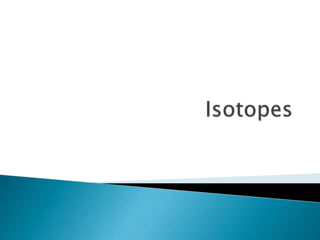Module 1 1.5a - isotopes
•Télécharger en tant que PPTX, PDF•
1 j'aime•713 vues
Module 1 1.5a - isotopes
Signaler
Partager
Signaler
Partager

Recommandé
Contenu connexe
Tendances
Tendances (20)
Similaire à Module 1 1.5a - isotopes
Similaire à Module 1 1.5a - isotopes (20)
Nuclear_Physics: A Guide to chemistry and nuclear physics

Nuclear_Physics: A Guide to chemistry and nuclear physics
A Rapid and Innovative Method for Prediction of Spin Multiplicity and Spin St...

A Rapid and Innovative Method for Prediction of Spin Multiplicity and Spin St...
Dernier
Dernier (20)
development of diagnostic enzyme assay to detect leuser virus

development of diagnostic enzyme assay to detect leuser virus
POGONATUM : morphology, anatomy, reproduction etc.

POGONATUM : morphology, anatomy, reproduction etc.
Thyroid Physiology_Dr.E. Muralinath_ Associate Professor

Thyroid Physiology_Dr.E. Muralinath_ Associate Professor
Module for Grade 9 for Asynchronous/Distance learning

Module for Grade 9 for Asynchronous/Distance learning
pumpkin fruit fly, water melon fruit fly, cucumber fruit fly

pumpkin fruit fly, water melon fruit fly, cucumber fruit fly
Use of mutants in understanding seedling development.pptx

Use of mutants in understanding seedling development.pptx
Pulmonary drug delivery system M.pharm -2nd sem P'ceutics

Pulmonary drug delivery system M.pharm -2nd sem P'ceutics
PATNA CALL GIRLS 8617370543 LOW PRICE ESCORT SERVICE

PATNA CALL GIRLS 8617370543 LOW PRICE ESCORT SERVICE
300003-World Science Day For Peace And Development.pptx

300003-World Science Day For Peace And Development.pptx
Module 1 1.5a - isotopes
- 2. To describe an isotope To explain how atomic mass can vary within one element To calculate the abundance of different isotopes
- 3. An element is usually defined by the number of protons in the nucleus If the number of protons changes the element changes The number of protons is equal to the number of electrons in an atom However the number of neutrons can change between different atoms of the same element
- 4. An isotope is a chemical with a different atomic mass but the same number of protons as another Take carbon as an example
- 5. The atomic mass of carbon on the periodic table is 12.011 This is the mean mass of carbon on Earth
- 6. To calculate the abundance of one isotope it is important to know the mass of all isotopes and the mass on the periodic table We are going to calculate the % abundance of carbon 12
- 7. It is firstly important to understand the concept of proportions and percentages Carbon 12 + carbon 14 = 100% of all carbon We are trying to find the % of 12C so we will call that x This means that: 12x + (100-x)14 / 100= 12.011 where x is % carbon 12, (100-x) is % carbon 14
- 8. 12x + (100-x)14/100 = 12.011 Multiply out the brackets 12x + 1400-14x /100= 12.011 Multiply by 100 to remove the /100 12x +1400 -14x = 1201.1 Subtract the whole number leaving only x on one side 12x – 14x = -198.9 -2x=-198.9 -x = 99.45 x = 99.45
- 9. Research to find an element that has 2 common isotopes Calculate the relative abundances of these 2 isotopes – If you find a website that offers you the information ensure that it is the correct answer! Write out an exam style question and give it to your neighbour
- 10. Average atomic mass = (abundance of isotope 1)(mass of isotope 1) + (abundance of isotope 2)(mass of isotope 2)
- 11. Isotope Isotopic mass (u) Isotopic abundance (%) 24Mg 24 78.99 25Mg 25 10.00 26Mg 26 11.01
- 12. (24)(0.7899)+(25)(0.10)+(16)(0.1101)= 18.9576 + 2.5 + 2.8626 = 24.3202
- 13. You will be given an element from the periodic table You will produce a short (3-4 minute) presentation about that element The presentation MUST include the electronic structure, isotopes of the element, symbol and position on the periodic table It should also include uses of the element, how it was discovered, impact of uses of the element (if applicable)
- 14. The student explains how science is applied and how it may be used to address a specific problem or issue in a local or global context. The student discusses the effectiveness of science and its application in solving the problem or issue. The student discusses and evaluates the implications of the use and application of science interacting with at least two of the following factors: moral, ethical, social, economic, political, cultural and environmental.
- 15. The student uses sufficient scientific language correctly. The student communicates scientific information effectively. When appropriate to the task, the student fully documents sources of information correctly.